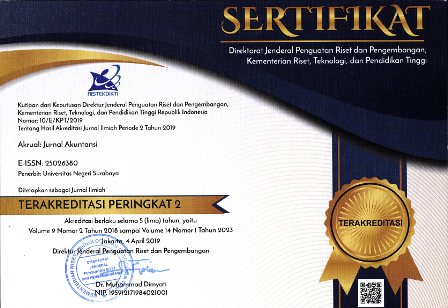Decision Usefulness Approach Of Accounting Information: Bagaimana Informasi Akuntansi Menjadi Useful ?
DOI:
https://doi.org/10.26740/jaj.v2n1.p92-108Keywords:
Usefulness of Accounting Information, Decision Usefulness ApproachAbstract
Abstract
Application of decision usefulness approach to produce accounting information that is relevant and reliable. Relevant information, that has the capacity to affect the confidence of investors about future returns, and should be released in a timely manner.The concept of decision usefulness of accounting information plays an important role in identifying problems for users of financial reports and selection of accounting information that users of financial statements to make the best decision. To apply the concept of decision usefulness is necessary linkages with the various theories in economics and finance. Decision usefulness approach assumes that individual decision makers are rational, that is individuals who will choose the action that will yield the highest expected utility.
References
Abarbanell JS, Lanen WN, Verrecchia RE, 1995. Analysts Forecasts as Proxies for Investor Beliefs in Empirical Research. Journal of Accounting and Economics, 20, pp. 31-60. https://doi.org/10.1016/0165-4101(94)00392-i
Alattar JM, Al-Khater K, 2007. An Empirical Investigation of Users Views on Corporate Annual Reports in Qatar. International Journal of Commerce and Management, vol. 17 no. 4, pp. 312-325. https://doi.org/10.1108/ 10569210710844381
Ball R, Brown P, 1968. An Empirical Evaluation of Accounting Income Numbers. Journal Of Accounting Research, pp. 159-178. https://doi.org/10.2307/2490232
Bamber, Barron, Stober, 1997. Trading Volumen and Different Aspects of Disagreement Coincident with Earnings Announcements. The Accounting Review, vol. 71 no. 4, pp. 575-597.
Banker, Das, Datar, 1993. Complementarity of Prior Accounting Information: The Case of Stock Dividend Announcements. The Accounting Review, vol. 68 no. 1, pg. 28.
Beaver WH, 1989. Financial Reporting: An Accounting Revolution. Second Edition. New Jersey: Prentice Hall.
Bodie, Kane, Marcus, 2009. Investment. 8th edition. McGraw-Hill Companies, Inc.
Collins DW, Kothari SP, 1989. An Analysis Of Intertemporal and Cross-Sectional Determinants Of Earnings Response Coefficients. Journal of Accounting and Economics, 11, pp. 143-181. https://doi.org/10.1016/0165-4101(89)90004-9
Day J, 1986. The Use of Annual Reports by UK Investment Analysis. Accounting and Business Research, pp. 295-307. https://doi.org/10.1080/ 00014788.1986.9729330
Dhaliwal DS, Lee KJ, Fargher NL, 1991. The Association Between Unexpected Earnings and Abnormal Security Returns In The Presence of Financial Leverage. Contemporary Accounting Research, vol. 8 no. 1, pp. 20-41. https://doi.org/10.1111/j.1911-3846.1991.tb00832.x
Easton PD, Zmijewski ME, 1989. Cross-Sectional Variation In The Stock Market Response To Accounting Earnings Announcements. Journal of Accounting and Economics, 11, pp. 117-141. https://doi.org/10.1016/0165-4101(89)90003-7
Eccles, Holt, 2005. Financial Statement and Corporate Accounts: The Conceptual Framework. Property Management, vol. 23 no. 5, pp. 374-387. https://doi.org/10.1108/02637470510631500
Financial Accounting Standard Board, 1978. Objectives of Financial Reporting by Business Enterprises. Statement of Financial Accounting Concepts No. 1. FASB, Stamford, Connecticut, November.
Financial Accounting Standard Board, 1980. Qualitative Characteristics of Accounting Information. Statement of Financial Accounting Concepts No. 2. FASB, Stamford, Connecticut, May.
Gniewosz G, 1990. The Share Investment Decision Process and Information Use: An Exploratory Case Study. Accounting and Business Research, vol. 20 no. 79, pp. 223-230. https://doi.org/10.1080/00014788.1990.9728880
Halim A, 2005. Analisis Investasi. Salemba Empat, Jakarta.
Hartono J, 2008. Teori Portofolio dan Analisis Investasi. Edisi Kelima. Yogyakarta: BPFE.
Haugen RA, 2001. Modern Investment Theory. Fifth Edition. New Jersey: Prentice Hall.
Kim O, Verrecchia RE, 1997. Pre-announcements and Event-Period Private Information. Journal of Accounting and Economics, 24, pp. 395-419. https://doi.org/10.1016/s0165-4101(98)00013-5
Kodrat DS, Herdinata C, 2009. Manajemen Keuangan Based On Empirical Research. Yogyakarta: Graha Ilmu.
Landsman WR, 2007. Is Fair Value Accounting Information Relevant and Reliable? Evidence from Capital Market Research. Special Issue: International Accounting Policy, pp. 19-30. https://doi.org/10.1080/00014788.2007.9730081
Lawrence, Kercsmar, 1999. Accounting Information Utilization and Judgment Quality In a Stock Investment Task. American Business Review, vol. 17 no. 1, pg. 7.
Louis PP, 1971. Readings in the History of Economic Thought. California: MrCutrhan Publishing Corporation.
Machfoedz M, 1999. Pengaruh Krisis Moneter pada Efisiensi Perusahaan Publik di Bursa Efek Jakarta. Jurnal Ekonomi dan Bisnis Indonesia, vol. 14, no. 1, pp. 37-49.
Maines, Wahlen, 2006. The Nature of Accounting Information Reliability: Inferences from Archival and Experimental Research. Accounting Horizons, vol. 20 no. 4, pp. 399-425. https://doi.org/10.2308/acch.2006.20.4.399
Moon, Keasey, 1992. Information and Decision Making: a Search for Method and Understanding. Managerial and Decision Economics, vol. 13 no. 5, pg. 44. https://doi.org/10.1002/mde.4090130508
Moeljadi, 2006. Manajemen Keuangan: Pendekatan Kuantitatif dan Kualitatif. Jilid 1. Malang: Bayumedia Publishing.
Pappas JL, Hirschey M, 1995. Ekonomi Manajerial. Jilid II. Edisi Keenam. Jakarta: Binarupa Aksara.
Pressman S, 2002. Lima Puluh Pemikir Ekonomi Dunia. Jakarta: PT. RajaGrafindo Persada.
Reilly FK, Brown KC, 2006. Investment Analysis and Portfolio Management. Eighth Edition. South Western: Thomson.
Samsul M, 2006. Pasar Modal dan Manajemen Portofolio. Jakarta: Penerbit Erlangga.
Samuelson WF, Marks SG, 2003. Managerial Economics. 4th Edition. New York: John Wiley & Sons, Inc.
Sanusi B, 2004. Tokoh Pemikir dalam Mazhab Ekonomi. Jakarta: Penerbit Rineka Cipta.
Scott WR, 2009. Financial Accounting Theory. Fourth Edition. Toronto, Ontario: Pearson Education Canada Inc.
Sembiring ER, 2005. Karakteristik Perusahaan dan Pengungkapan Tanggung Jawab Sosial: Studi Empiris pada Perusahaan yang Tercatat di Bursa Efek Jakarta. Simposium Nasional Akuntansi 8 - Solo, pp. 379-395.
Siegel G, Marconi HR, 1989. Behavioral Accounting. South_Western Publishing Co., Ohio.
Standar Akuntansi Keuangan, 2009. Kerangka Dasar Penyusunan dan Penyajian Laporan Keuangan. Penerbit Salemba Empat, Jakarta.
Suwarjono, 2008. Teori Akuntansi: Perekayasaan Pelaporan Keuangan. Edisi Ketiga. Yogyakarta: BPFE.
Wignjohartojo P, 1995. Sikap Akuntan Pendidik Dan Pemakai Laporan Keuangan Terhadap Penggunaan Pengembangan Laporan Keuangan Untuk Membuat Keputusan Investasi Pada Saham. Disertasi. Program Pascasarjana. Universitas Airlangga. Surabaya.
Wolk HI, Dood JL, Tearney MG, 2004. Accounting Theory: Conceptual Issues in a Political and Economic Environment. 6th Edition. Thomson, South-Western.
Downloads
Published
How to Cite
Issue
Section
 Abstract views: 3598
,
Abstract views: 3598
, PDF Downloads: 3693
PDF Downloads: 3693


















